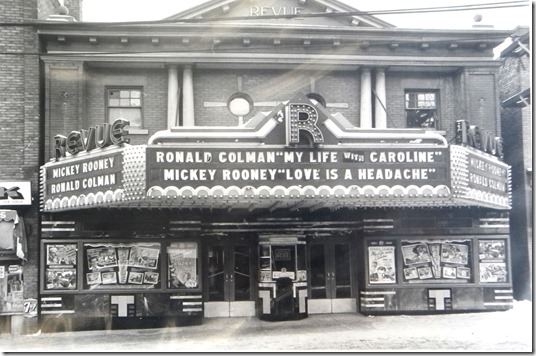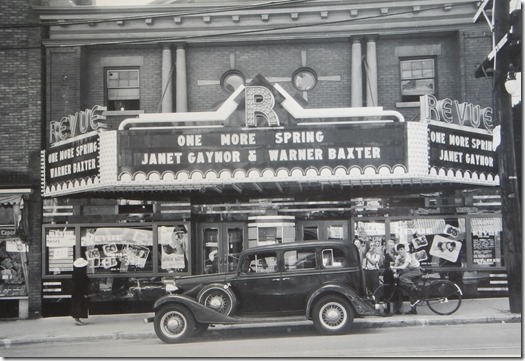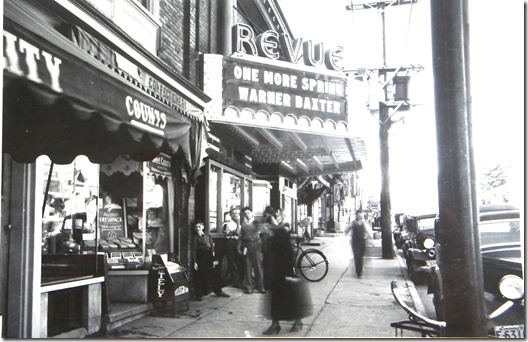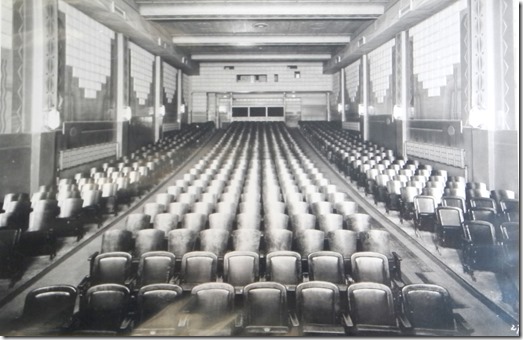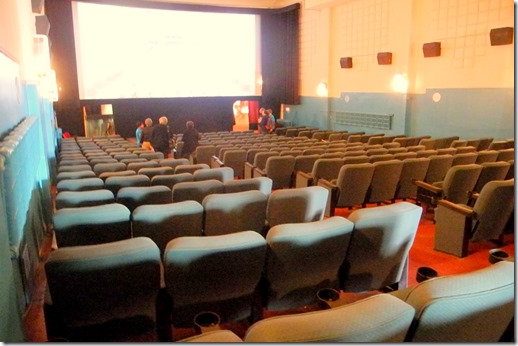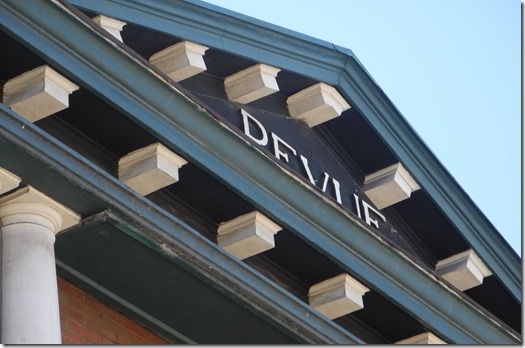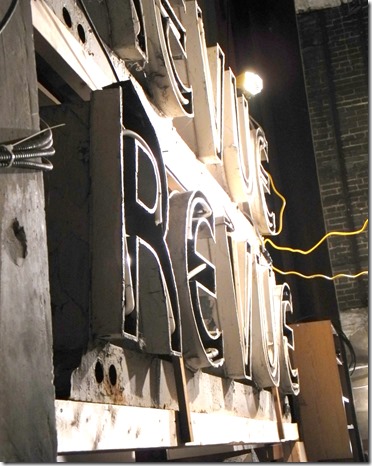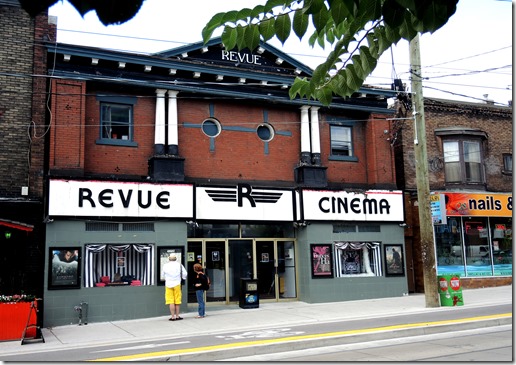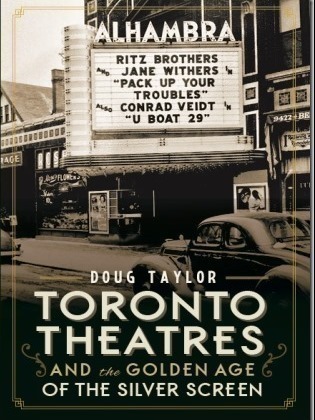The Revue Theatre in 1938, Ontario Archives.
The Revue Theatre at 400 Roncesvalles Avenue is one of the oldest surviving movie houses in Toronto, its only rival for this distinction being the Fox Theatre, on Queen Street East. Both theatres opened between 1912 and 1913 and remain active today. Their façades are unchanged from when they opened, although the original marquees on both theatres have been removed as they were too costly to maintain.
Because of the Revue’s location, I was never inside it when I was a teenager. However, during “Doors Open Toronto” in 2013, I journeyed on the streetcar to visit it. I had my choice of boarding either a King or a College streetcar, as the theatre is located near the intersection of Roncesvalles and Howard Park Avenues. This caused me to realize the advantage of the theatre’s location in earlier decades, when almost everyone moved around the city by streetcar. On arriving at the theatre, I was impressed with the young volunteers that enthusiastically talked about the Revue and provided tours of the space behind the screen. They also allowed access to the projection room. Free popcorn was available at the candy bar—a nice touch.
In the mid-19th century, the area known as Parkdale, to the south of where the Revue is located today, was relative undeveloped. However, it was expanding rapidly, even though it was considered remote from the downtown. Nestled beside Lake Ontario, many of its inhabitants were cottagers who spent only the summer months in Parkdale, sharing it with people who were enjoying day-trips to the beach from the core of the city. However, because of its highly desirable location beside the lake, Parkdale increasingly attracted more and more permanent residents, many large Victorian-style homes appearing on its tree-lined streets. As a result, it was annexed to the City of Toronto in 1889. As land prices increased and vacant residential lots disappeared, residential development moved further northward, along Roncesvalles Avenue. This street derived its name from a mountain pass in the Pyrenees, where a battle was fought in the Napoleonic Wars.
As the area of Roncesvalles near Howard Park Avenue became more populated, it was obvious that building a movie theatre in the area could be a profitable enterprise. Thus, between 1912-1913, the Revue Theatre was constructed. Though in a quiet neighbourhood to the northwest of the downtown core, it benefited from being close to two streetcar lines and surrounded by residential streets to the east and west of Roncesvalles with ever-increasing populations .
People arriving at the terminus of the College streetcar line in High Park in 1906, on an open trolley car. This was only a few blocks from where the Revue Theatre was located. City of Toronto Archives, Series 71, Item 9896
The Revue was not a large theatre, containing only around 500 seats. However, its size was appropriate for a local theatre that depended mainly on the surrounding community for patrons, supplemented by those who arrived by streetcar. The theatre’s Fabricord seats were comfortable, and its two aisles provided easy access and exiting of the theatre. This was an advantage in an era when movie-goers entered and departed constantly, rather than arriving at the staring time of a film. Despite the theatre’s modest size, it possessed an impressive marquee, attached to a façade displaying classical designs, with Greek dentils and Doric columns. The cornice on the peaked roof and the horizontal lower cornice below it contained classical decorative detailing. The interior was decorated with designs possessing geometric shapes and patterns.
In the 1980s, the theatre became part of the Festival Theatre chain. However, in 2006 the company closed the Revue. It appeared as if a developer might purchase the property and demolish it. Fortunately, concerned residents raised funds to ensure its survival as a functioning movie house. It reopened the following year, operated by the non-profit Revue Film Society.
In February of the year it reopened, a section of the marquee collapsed to the sidewalk, likely cause by the weight of the snow. For safety reasons, it was necessary to remove the entire marquee. A part of it was preserved by storing it in an area behind the screen.
Thankfully, the Revue Cinema remains today and continues to offer nightly screenings. It is one of Toronto’s few remaining neighbourhood theatres of yesteryear.
The Revue Theatre in 1935, City of Toronto Archives, Series 1109 File 106
The Revue Theatre in 1935, City of Toronto Archives, Series 1111, It. 108
Interior of the Revue Theatre in the 1930s, City of Toronto Archives.
Interior of the theatre in 2013, from the rear of the auditorium.
View of the auditorium from near the screen.
Greek dentils in the peak of the facade and the name of the theatre.
A section of the old marquee that is stored behind the screen.
Facade of the Revue Theatre in 2013.
To view the Home Page for this blog: https://tayloronhistory.com/
To view previous blogs about movie houses of Toronto—historic and modern
Recent publication entitled “Toronto’s Theatres and the Golden Age of the Silver Screen,” by the author of this blog. The publication explores 50 of Toronto’s old theatres and contains over 80 archival photographs of the facades, marquees and interiors of the theatres. It relates anecdotes and stories of the author and others who experienced these grand old movie houses.
To place an order for this book:
Book also available in Chapter/Indigo, the Bell Lightbox Book Store and by phoning University of Toronto Press, Distribution: 416-667-7791
Theatres Included in the Book:
Chapter One – The Early Years—Nickelodeons and the First Theatres in Toronto
Theatorium (Red Mill) Theatre—Toronto’s First Movie Experience and First Permanent Movie Theatre, Auditorium (Avenue, PIckford), Colonial Theatre (the Bay), the Photodome, Revue Theatre, Picture Palace (Royal George), Big Nickel (National, Rio), Madison Theatre (Midtown, Capri, Eden, Bloor Cinema, Bloor Street Hot Docs), Theatre Without a Name (Pastime, Prince Edward, Fox)
Chapter Two – The Great Movie Palaces – The End of the Nickelodeons
Loew’s Yonge Street (Elgin/Winter Garden), Shea’s Hippodrome, The Allen (Tivoli), Pantages (Imperial, Imperial Six, Ed Mirvish), Loew’s Uptown
Chapter Three – Smaller Theatres in the pre-1920s and 1920s
Oakwood, Broadway, Carlton on Parliament Street, Victory on Yonge Street (Embassy, Astor, Showcase, Federal, New Yorker, Panasonic), Allan’s Danforth (Century, Titania, Music Hall), Parkdale, Alhambra (Baronet, Eve), St. Clair, Standard (Strand, Victory, Golden Harvest), Palace, Bedford (Park), Hudson (Mount Pleasant), Belsize (Crest, Regent), Runnymede
Chapter Four – Theatres During the 1930s, the Great Depression
Grant ,Hollywood, Oriole (Cinema, International Cinema), Eglinton, Casino, Radio City, Paramount, Scarboro, Paradise (Eve’s Paradise), State (Bloordale), Colony, Bellevue (Lux, Elektra, Lido), Kingsway, Pylon (Royal, Golden Princess), Metro
Chapter Five – Theatres in the 1940s – The Second World War and the Post-War Years
University, Odeon Fairlawn, Vaughan, Odeon Danforth, Glendale, Odeon Hyland, Nortown, Willow, Downtown, Odeon Carlton, Donlands, Biltmore, Odeon Humber, Town Cinema
Chapter Six – The 1950s Theatres
Savoy (Coronet), Westwood
Chapter Seven – Cineplex and Multi-screen Complexes
Cineplex Eaton Centre, Cineplex Odeon Varsity, Scotiabank Cineplex, Dundas Square Cineplex, The Bell Lightbox (TIFF)
